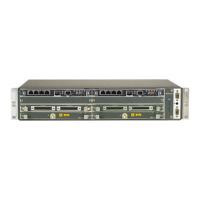User Manual
Product information and planning
9500 MPR Rel. 3.1
3DB18809AAAA Issue 1 139/980
2.8.4.1 ODU block diagram
Figure 60.shows the ODU block diagram.
Figure 60. ODU block diagram
The quadrature modulated 311 MHz IF signal from the MSS is extracted at the N-Plexer and passed via
a cable AGC circuit to an IQ demodulator/modulator.
Here the 311 MHz IF is demodulated to derive the separate I and Q signals using the 10 MHz
synchronizing reference signal from the MSS.
These I and Q signals modulate a Tx IF, which has been set to a specific frequency between 1700 and
2300 MHz, such that when mixed with the Tx local oscillator signal (TXLO) in the subsequent mixer stage,
provides the selected transmit frequency. Both the IF and Tx local oscillators are synthesizer types.
Between the IQ modulator and the mixer, a variable attenuator provides software adjustment of Tx power.
After the mixer, the transmit signal is amplified in the PA (Power Amplifier) and passed via the diplexer
to the antenna feed port.
A microprocessor in the ODU supports configuration of the synthesizers, transmit power, and alarm and
performance monitoring. The ODU microprocessor is managed under the NCC microprocessor, with
which it communicates via the telemetry channel.
A DC-DC converter provides the required low-voltage DC rails from the -48 Vdc supply.
In the receive direction, the signal from the diplexer is passed via the LNA (Low Noise Amplifier) to the
Rx mixer, where it is mixed with the receive local oscillator (RXLO) input to provide an IF of between 1700
and 2300 MHz. It is then amplified in a gain-controlled stage to compensate for fluctuations in receive
level, and in the IF mixer, is converted to a 126 MHz IF for transport via the ODU cable to the MSS.
The offset of the transmit frequencies at each end of the link is determined by the required Tx/Rx split.
The split options provided are based on ETSI plans for each frequency band. The actual frequency range
per band and the allowable Tx/Rx splits are range-limited within 9500 MPR-E to prevent incorrect user
selection.
MSS

